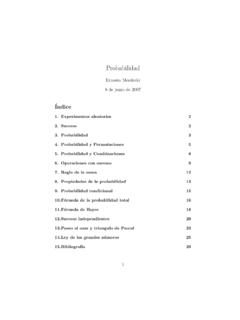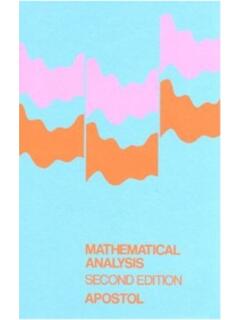Transcription of REAL ANALYSIS - Centro de Matemática
1 REAL ANALYSISI bookroot October 20, 2007 PrincetonLecturesinAnalysisI Fourier ANALYSIS : An IntroductionII Complex AnalysisIII Real ANALYSIS : Measure Theory, integration , andHilbert SpacesIV Functional ANALYSIS : Introductionto Further Topics in AnalysisPrinceton Lectures in AnalysisIIIREAL ANALYSISM easure Theory, integration , andHilbert SpacesElias M. Stein&Rami ShakarchiPRINCETON UNIVERSITY PRESSPRINCETON AND OXFORDC opyright 2005 by Princeton University PressPublished by Princeton University Press, 41 William Street,Princeton, New Jersey 08540In the United Kingdom: Princeton University Press, 6 Oxford Street, Woodstock, Oxfordshire OX20 1 TWAll Rights ReservedLibrary of Congress Control Number 2004114065 ISBN 978-0-691-11386-9 British Library Cataloging-in-Publication Data is availableThe publisher would like to acknowledge the authors of this volume for providing the camera-ready copy from which this book was printedPrinted on acid-free paper. in the United States of America5 7 9 10 8 643To my grandchildrenCarolyn, Alison, my parentsMohamed & Mireilleand my in the spring of 2000, a series of four one-semester courseswere taught at Princeton University whose purpose was to present, inan integrated manner, the core areas of ANALYSIS .
2 The objective was tomake plain the organic unity that exists between the various parts of thesubject, and to illustrate the wide applicability of ideas of ANALYSIS toother fields of mathematics and science. The present series of books isan elaboration of the lectures that were there are a number of excellent texts dealing with individualparts of what we cover, our exposition aims at a different goal: pre-senting the various sub-areas of ANALYSIS not as separate disciplines, butrather as highly interconnected. It is our view that seeing these relationsand their resulting synergies will motivate the reader to attain a betterunderstanding of the subject as a whole. With this outcome in mind, wehave concentrated on the main ideas and theorems that have shaped thefield (sometimes sacrificing a more systematic approach), and we havebeen sensitive to the historical order in which the logic of the have organized our exposition into four volumes, each reflectingthe material covered in a semester.
3 Their contents may be broadly sum-marized as series and theory, Lebesgue integration , and Hilbert selection of further topics, including functional ANALYSIS , distri-butions, and elements of probability , this listing does not by itself give a complete picture ofthe many interconnections that are presented, nor of the applicationsto other branches that are highlighted. To give a few examples: the ele-ments of (finite) Fourier series studied in Book I, which lead to Dirichletcharacters, and from there to the infinitude of primes in an arithmeticprogression; theX-ray and Radon transforms, which arise in a number ofviiiFOREWORD problems in Book I, and reappear in Book III to play an important role inunderstanding Besicovitch-like sets in two and three dimensions; Fatou stheorem, which guarantees the existence of boundary values of boundedholomorphic functions in the disc, and whose proof relies on ideas devel-oped in each of the first three books; and the theta function, which firstoccurs in Book I in the solution of the heat equation, and is then usedin Book II to find the number of ways an integer can be represented asthe sum of two or four squares, and in the analytic continuation of thezeta few further words about the books and the courses on which theywere based.
4 These courses where given at a rather intensive pace, with 48lecture-hours a semester. The weekly problem sets played an indispens-able part, and as a result exercises and problems have a similarly im-portant role in our books. Each chapter has a series of Exercises thatare tied directly to the text, and while some are easy, others may requiremore effort. However, the substantial number of hints that are givenshould enable the reader to attack most exercises. There are also moreinvolved and challenging Problems ; the ones that are most difficult, orgo beyond the scope of the text, are marked with an the substantial connections that exist between the differentvolumes, enough overlapping material has been provided so that each ofthe first three books requires only minimal prerequisites: acquaintancewith elementary topics in ANALYSIS such as limits, series, differentiablefunctions, and Riemann integration , together with some exposure to lin-ear algebra. This makes these books accessible to students interestedin such diverse disciplines as mathematics, physics, engineering, andfinance, at both the undergraduate and graduate is with great pleasure that we express our appreciation to all whohave aided in this enterprise.
5 We are particularly grateful to the stu-dents who participated in the four courses. Their continuing interest,enthusiasm, and dedication provided the encouragement that made thisproject possible. We also wish to thank Adrian Banner and Jos e LuisRodrigo for their special help in running the courses, and their efforts tosee that the students got the most from each class. In addition, AdrianBanner also made valuable suggestions that are incorporated in the wish also to record a note of special thanks for the following in-dividuals: Charles Fefferman, who taught the first week (successfullylaunching the whole project!); Paul Hagelstein, who in addition to read-ing part of the manuscript taught several weeks of one of the courses, andhas since taken over the teaching of the second round of the series; andDaniel Levine, who gave valuable help in proof-reading. Last but notleast, our thanks go to Gerree Pecht, for her consummate skill in type-setting and for the time and energy she spent in the preparation of allaspects of the lectures, such as transparencies, notes, and the are also happy to acknowledge our indebtedness for the supportwe received from the 250th Anniversary Fund of Princeton University,and the National Science Foundation s VIGRE M.
6 SteinRami ShakarchiPrinceton, New JerseyAugust 2002In this third volume we establish the basic facts concerning measuretheory and integration . This allows us to reexamine and develop furtherseveral important topics that arose in the previous volumes, as well as tointroduce a number of other subjects of substantial interest in aid the interested reader, we have starred sections that contain moreadvanced material. These can be omitted on first reading. We also wantto take this opportunity to thank Daniel Levine for his continuing help inproof-reading and the many suggestions he made that are incorporatedin the 2004 ContentsForewordviiIntroductionxv1 Fourier series: completionxvi2 Limits of continuous functionsxvi3 Length of curvesxvii4 Differentiation and integrationxviii5 The problem of measurexviiiChapter 1. Measure Theory11 Preliminaries12 The exterior measure103 Measurable sets and the Lebesgue measure164 Measurable Definition and basic Approximation by simple functions or step Littlewood s three principles335* The Brunn-Minkowski inequality346 Exercises377 Problems46 chapter 2.
7 integration Theory491 The Lebesgue integral: basic properties and convergencetheorems492 The spaceL1of integrable functions683 Fubini s Statement and proof of the Applications of Fubini s theorem804* A Fourier inversion formula865 Exercises896 Problems95 chapter 3. Differentiation and Integration981 Differentiation of the The Hardy-Littlewood maximal The Lebesgue differentiation theorem1042 Good kernels and approximations to the identity108xixiiCONTENTS3 Differentiability of Functions of bounded Absolutely continuous Differentiability of jump functions1314 Rectifiable curves and the isoperimetric * Minkowski content of a * Isoperimetric inequality1435 Exercises1456 Problems152 chapter 4. Hilbert Spaces: An Introduction1561 The Hilbert spaceL21562 Hilbert Unitary Pre-Hilbert spaces1693 Fourier series and Fatou s Fatou s theorem1734 Closed subspaces and orthogonal projections1745 Linear Linear functionals and the Riesz representation Examples1856 Compact operators1887 Exercises1938 Problems202 chapter 5.
8 Hilbert Spaces: Several Examples2071 The Fourier transform onL22072 The Hardy space of the upper half-plane2133 Constant coefficient partial differential Weak The main theorem and key estimate2244* The Dirichlet Harmonic The boundary value problem and Dirichlet s principle2435 Exercises2536 Problems259 CONTENTS xiiiChapter 6. Abstract Measure and integration Theory2621 Abstract measure Exterior measures and Carath eodory s Metric exterior The extension theorem2702 integration on a measure space2733 Product measures and a general Fubini integration formula for polar Borel measures onRand the Lebesgue-Stieltjes in-tegral2814 Absolute continuity of Signed Absolute continuity2885* Ergodic Mean ergodic Maximal ergodic Pointwise ergodic Ergodic measure-preserving transformations3026* Appendix: the spectral Statement of the Positive Proof of the Spectrum3117 Exercises3128 Problems319 chapter 7. Hausdorff Measure and Fractals3231 Hausdorff measure3242 Hausdorff Self-similarity3413 Space-filling Quartic intervals and dyadic Dyadic Construction of the Peano mapping3554* Besicovitch sets and The Radon Regularity of sets whend Besicovitch sets have dimension Construction of a Besicovitch set374xivCONTENTS5 Exercises3806 Problems385 Notes and References389 Bibliography391 Symbol Glossary395 Index397 IntroductionI turn away in fright and horror from this lamentableplague of functions that do not have Hermite,1893 Starting in about 1870 a revolutionary change in the conceptual frame-work of ANALYSIS began to take shape, one that ultimately led to a vasttransformation and generalization of the understanding of such basic ob-jects as functions, and such notions as continuity, differentiability, earlier view that the relevant functions in ANALYSIS were given byformulas or other analytic expressions.
9 That these functions were bytheir nature continuous (or nearly so), that by necessity such functionshad derivatives for most points, and moreover these were integrable bythe accepted methods of integration all of these ideas began to giveway under the weight of various examples and problems that arose inthe subject, which could not be ignored and required new concepts tobe understood. Parallel with these developments came new insights thatwere at once both more geometric and more abstract: a clearer under-standing of the nature of curves, their rectifiability and their extent; alsothe beginnings of the theory of sets, starting with subsets of the line, theplane, etc., and the measure that could be assigned to is not to say that there was not considerable resistance to thechange of point-of-view that these advances required. Paradoxically,some of the leading mathematicians of the time, those who should havebeen best able to appreciate the new departures, were among the oneswho were most skeptical.
10 That the new ideas ultimately won out canbe understood in terms of the many questions that could now be ad-dressed. We shall describe here, somewhat imprecisely, several of themost significant such Fourier series: completionWheneverfis a (Riemann) integrable function on [ , ] we defined inBook I its Fourier seriesf aneinxby(1)an=12 f(x)e inxdx,and saw then that one had Parseval s identity, n= |an|2=12 |f(x)| , the above relationship between functions and their Fouriercoefficients is not completely reciprocal when limited to Riemann inte-grable functions. Thus if we consider the spaceRof such functions withits square norm, and the space`2(Z) with its norm,1each elementfinRassigns a corresponding element{an}in`2(Z), and the two norms areidentical. However, it is easy to construct elements in`2(Z) that do notcorrespond to functions inR. Note also that the space`2(Z) iscompletein its norm, whileRis we are led to two questions:(i)What are the putative functions fthat arise when we completeR?


